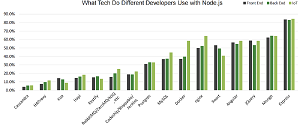News
Node.js Survey: Enterprise Inroads, New Meaning for 'Full Stack' Developers
- By David Ramel
- April 20, 2016
A new survey from the Node.js Foundation shows the open source JavaScript platform is making inroads into enterprise dev shops, where the term "full stack developer" has a new meaning, making room for the burgeoning Internet of Things (IoT).
Variously termed a platform, runtime environment and development language, Node.js is officially described by its governing organization -- operating under the auspices of the Linux Foundation -- as "a JavaScript runtime built on Chrome's V8 JavaScript engine. Node.js uses an event-driven, non-blocking I/O model that makes it lightweight and efficient. Node.js' package ecosystem, npm, is the largest ecosystem of open source libraries in the world."
Whatever you call it, Node.js is seeing increasing enterprise adoption, according to the Node.js 2016 User Survey Report, released last week.
"Node.js is increasingly used in the enterprise, and used within huge enterprises like PayPal, Go Daddy, Capital One and Intel," the Node.js Foundation said in a blog post. The survey of 1,760 people worldwide conducted early this year found:
- More than 45 percent already using the Node.js Long Term Support release (v4) geared toward medium to large enterprise users who require stability and high performance.
- Of those who haven’t upgraded, 80 percent report definite plans to upgrade to v4, with half of respondents planning to do so this year.
- Strong interest in enterprise tooling among 34 percent of tech leaders.
The Foundation also said Node.js was becoming a universal development platform, giving rise to a new meaning for the term "full stack," which used to just comprise front-end and back-end development. With the growing IoT phenomenon, "the full stack is no longer 'front end and back end,' but rather 'front end, back end and connected devices,' " the organization said. The new definition describes "a combination of everything from the browser to a toaster all being run in JavaScript and enabled by Node.js."
Along with IoT, the growing container movement also displays an affinity for Node.js developers, the Foundation said.
"JavaScript and Node.js have risen to be the language and platform of choice for IoT as both are suited for data intensive environments that require parallel programming without disruption," the Foundation said. "JavaScript, including Node.js and frameworks, such as React, have become the de facto choice of developers working in these connected, device-driven environments with 96 percent of IoT respondents indicating they use JavaScript/Node.js for development."
Furthermore, "although Docker is a server technology, many IoT developers (58 percent) are using Node.js with Docker compared to only 39 percent of back-end developers. This metric is significant as it means that the new IoT world also is quickly adopting containers and microservices."
Along with the new definition of "full stack," the Foundation identified exploding growth in the full "MEAN" stack, describing the ancillary technologies often used by Node.js developers in today's new tech world.
 [Click on image for larger view.]
Popular Technologies Used with Node.js (source: Node.js Foundation)
[Click on image for larger view.]
Popular Technologies Used with Node.js (source: Node.js Foundation)
"The popularity of real-time, social networking and interactive game applications is pushing a new stack among developers," the Foundation said. "The MEAN stack is able to handle lots of concurrent connections and extreme scalability, which these applications demand. Node.js, in combination with MongoDB, Express, AngularJS, allows developers to tackle the needs of front-end and back-end development. Not surprisingly, all of these technologies were commonly used alongside Node.js. Express, cited the most, is used by an average of 83 percent of developers."
Those developers are also fond of using languages such as PHP, Java, Python, .NET, Ruby, C++, Go and Scala, which are listed by their popularity among respondents. Going forward, the only languages projected to see more use among front-end, back-end and IoT developers are JavaScript, naturally, followed by Go, Python and C++, which will see the most future use among IoT developers.
Other findings of the survey include:
-
Developers and tech leaders overwhelmingly rely on documentation, online training/tutorials and forums such as Stack Overflow, though they want to see more resources available in the form of meet-ups/local events and enterprise tooling.
- Web apps see the most development time among respondents, followed by enterprise, hobbyist, Big Data/analytics and IoT.
- 52 percent of respondents have more than five years of professional development experience; 81 percent have three years or less experience with Node.js. A much higher percentage of IoT developers report having more than 10 years of experience.
- IoT developers show a much higher affinity for using PHP, Python and C++ when compared to their back-end and front-end colleagues.
 [Click on image for larger view.]
JavaScript, Node.js Enjoying Popularity (source: Node.js Foundation)
[Click on image for larger view.]
JavaScript, Node.js Enjoying Popularity (source: Node.js Foundation)
Overall, the Foundation points to a very healthy Node.js ecosystem. "By many measures, Node.js is the fastest growing and most significant development language right now," the Foundation said. "With 3.5 million users and an annual growth rate of 100 percent, Node.js is truly everywhere."
About the Author
David Ramel is an editor and writer at Converge 360.